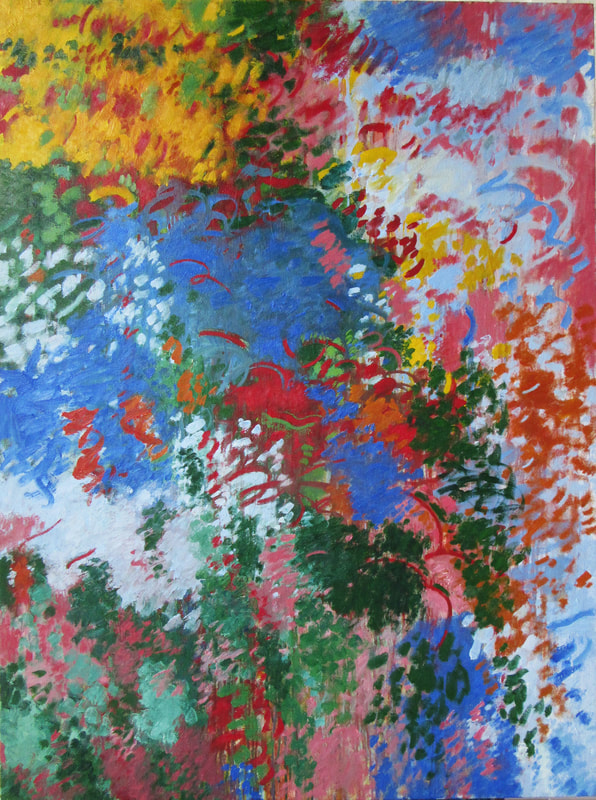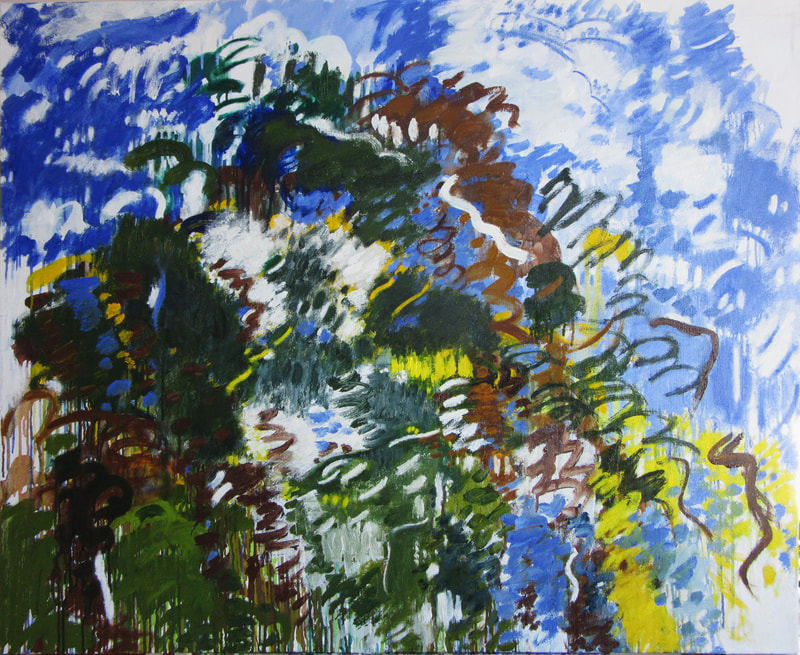February 2022
INVITATIONAL EXHIBITION
Lorna Ritz
Artist Statement
I am a third-generation abstract expressionist-impressionist painter. As a child, I sketched rooftops from the top of a three-story tenement building overlooking the city. I witnessed homeless people in the streets below and became politically aware. Years later, I worked with a realist painter at the Art Students League in NYC, but was not convinced by how realistically he wanted me to paint, devoid of emotional expression. I then met my undergraduate abstract expressionist teacher, who changed the course of my “painting-life.” Concepts he put forth are continually evolving within me to this day. They animated in me reminders of my life in the streets from years earlier. I best express my most passionate realities (the story beneath ordinary everyday life things), producing on canvas much of what people feel when they get religious.
I plan on continuing in the direction my paintings are already headed. It takes time in deep concentration without interruption to allow one painting to beget the one yet to come. I always have to find my way into a new painting all over again. Whenever I have ever gone to the painting with an idea from the previous painting, the act of touching paint quickly undoes the idea. I allow myself to tightrope my way in without a net underneath, by allowing the paint to guide me through. I look for spatial relationships right away; the color finds the shape, creates the volume between them. Once ideas start connecting, the dialogue between ideas becomes like a narrative story I am telling. I work oil on canvas (the abstract paintings), and oil crayon on paper (the landscape drawings). I scrape away what does not work: in painting with a pallet knife, and in drawing with a razor blade to remove the oil crayon, then drawing into the crayon with the razor. Nothing scraped gets discarded: I reuse everything. When oil paint gets scraped, the mud color is warmed up or cooled down with another color in order to obtain the exact temperature range. I even use the color that sank to the bottom of the can to begin another painting with thin washes. Just a really excellent quality of oil paint dictates the application thinner or straight from the tube, but all my colors are mixed. I only use five colors; with those, I can get every color: cadmium yellow light, cadmium red deep, cobalt blue, thalo blue, and titanium zinc white.
How I place shapes together becomes the structure in both the paintings and the drawings: ‘(where’ they exist in space in relationship to each other). The picture plane in the paintings changes constantly through the volume that color creates, (in a constant state of relational movement). What one thinks is coming forward then shoots back when in relationship to something else coming forward. In the landscapes everything that exists between gravity and sky exists in relationship to everything else, (i.e., the sky pulls back further proportionately to the foreground coming forward).
The general misunderstanding of a painting is due to missing it’s spiritual and technical qualities. If the observer’s eye is not trained to equate formal visual problems with those things, he/she will search for things which have little to do with the aesthetic content of a painting, looking for representational things instead of music-like relationships.
Each of my paintings represents a crystallized chunk of formal experience, while being very personal at the same time. My paintings are earthy, rock-like, and weighty, and yet they have in them the rhythm of the sea. I am a nature painter; the nature “out there” coupled with my own internal landscape. My inner finds the equivalent “out there.” My painting process is unsettling, passionate, radical, and driven. Altogether, a body of paintings becomes like the movements of a symphony that take a year or more to fully realize. Each painting has immediacy to it, but takes time to complete; it’s my own personal paradox. The painting is the consequence of technique and skill brought about by the concept. That is how what ends up on my canvas gets said, and how my paintings come to be.
INVITATIONAL EXHIBITION
Lorna Ritz
Artist Statement
I am a third-generation abstract expressionist-impressionist painter. As a child, I sketched rooftops from the top of a three-story tenement building overlooking the city. I witnessed homeless people in the streets below and became politically aware. Years later, I worked with a realist painter at the Art Students League in NYC, but was not convinced by how realistically he wanted me to paint, devoid of emotional expression. I then met my undergraduate abstract expressionist teacher, who changed the course of my “painting-life.” Concepts he put forth are continually evolving within me to this day. They animated in me reminders of my life in the streets from years earlier. I best express my most passionate realities (the story beneath ordinary everyday life things), producing on canvas much of what people feel when they get religious.
I plan on continuing in the direction my paintings are already headed. It takes time in deep concentration without interruption to allow one painting to beget the one yet to come. I always have to find my way into a new painting all over again. Whenever I have ever gone to the painting with an idea from the previous painting, the act of touching paint quickly undoes the idea. I allow myself to tightrope my way in without a net underneath, by allowing the paint to guide me through. I look for spatial relationships right away; the color finds the shape, creates the volume between them. Once ideas start connecting, the dialogue between ideas becomes like a narrative story I am telling. I work oil on canvas (the abstract paintings), and oil crayon on paper (the landscape drawings). I scrape away what does not work: in painting with a pallet knife, and in drawing with a razor blade to remove the oil crayon, then drawing into the crayon with the razor. Nothing scraped gets discarded: I reuse everything. When oil paint gets scraped, the mud color is warmed up or cooled down with another color in order to obtain the exact temperature range. I even use the color that sank to the bottom of the can to begin another painting with thin washes. Just a really excellent quality of oil paint dictates the application thinner or straight from the tube, but all my colors are mixed. I only use five colors; with those, I can get every color: cadmium yellow light, cadmium red deep, cobalt blue, thalo blue, and titanium zinc white.
How I place shapes together becomes the structure in both the paintings and the drawings: ‘(where’ they exist in space in relationship to each other). The picture plane in the paintings changes constantly through the volume that color creates, (in a constant state of relational movement). What one thinks is coming forward then shoots back when in relationship to something else coming forward. In the landscapes everything that exists between gravity and sky exists in relationship to everything else, (i.e., the sky pulls back further proportionately to the foreground coming forward).
The general misunderstanding of a painting is due to missing it’s spiritual and technical qualities. If the observer’s eye is not trained to equate formal visual problems with those things, he/she will search for things which have little to do with the aesthetic content of a painting, looking for representational things instead of music-like relationships.
Each of my paintings represents a crystallized chunk of formal experience, while being very personal at the same time. My paintings are earthy, rock-like, and weighty, and yet they have in them the rhythm of the sea. I am a nature painter; the nature “out there” coupled with my own internal landscape. My inner finds the equivalent “out there.” My painting process is unsettling, passionate, radical, and driven. Altogether, a body of paintings becomes like the movements of a symphony that take a year or more to fully realize. Each painting has immediacy to it, but takes time to complete; it’s my own personal paradox. The painting is the consequence of technique and skill brought about by the concept. That is how what ends up on my canvas gets said, and how my paintings come to be.

Ritz is a 3rd-generation abstract expressionist-impressionist painter. BFA Pratt Institute, MFA Cranbrook Academy Art. Taught: R.I. School of Design, Brown U, U of Minnesota, Dartmouth College, "Guest Critic" Vermont Studio Center 1991–2013, (through the US Information Agency),@ universities in Honduras, Colombia, Malta, American U, (D.C.), in Umbra, Italy, Institute American Universities, Aix-en-Provence, and through UMASS South Africa. Solo exhibitions: Art-in-Embassies Program, D.C. (Africa, Guatemala, Cape Verde, Caracas, Hong Kong; Divinity Center, Yale U, Oresman Gallery, Brown Fine Arts Center @, Smith College, Fine Arts Center's Contemporary Art Museum, U MASS; group shows: Anita Shapolsky Gallery, NYC, Hood Museum @ Dartmouth College, Fine Arts Center, Provincetown. Collections:Mead Art Museum, Amherst College,Hale and Dorr Law Firm, Bank of Boston, Johnson and Johnson, (N.J.), Anderson Museum Contemporary Art, (N.M.), Dana Farber Cancer Institute, Childrens’ Hospital, Cedars-Sinai Hospital, LA. Grants: Esther & Adolph Gottlieb Foundation Individual Support Grant, Pollock-KrasnerAward, Kittredge Fund, Harvard U; Puffin Foundation, George Sugarman Foundation Award.






